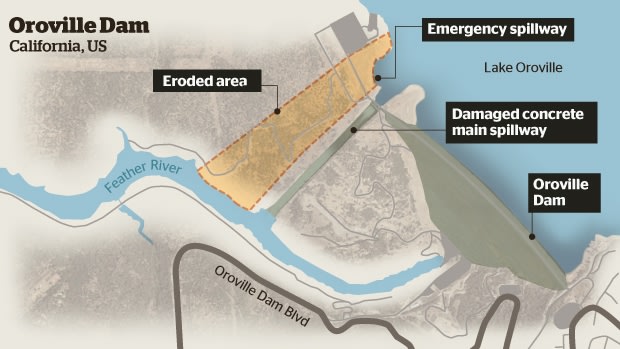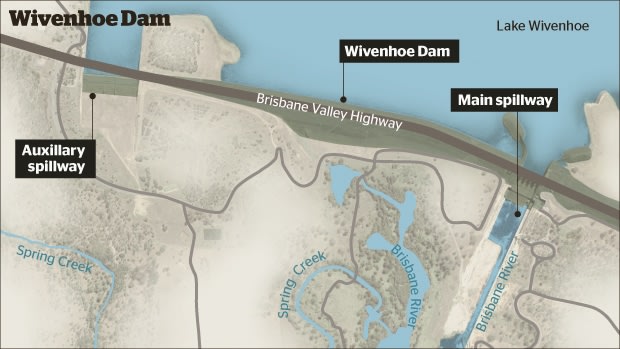This was published 8 years ago
'Political skulduggery': the inside story of how Wivenhoe became a substandard dam
By Mark Solomons
The chair of the 2011 floods inquiry called it "at once the most valuable and the most dangerous piece of infrastructure in Queensland".
If Wivenhoe Dam failed, it's estimated 400 people would die, 300,000 would be in danger, and the community would face a bill of at least $100 billion. Brisbane's main source of drinking water would be destroyed.

Wivenhoe Dam, deemed the most valuable and dangerous piece of infrastructure in Queensland.Credit: Dean Saffron
So for many it will be a surprise to learn that Wivenhoe and its concrete feeder dam upstream, Somerset, have long been considered substandard dams.
Neither has complied with national safety standards since about 2002, when meteorologists realised they had significantly underestimated the potential size of extreme rain events. The problem affects almost half of Seqwater's 26 large dams.

Wivenhoe Dam releasing water during 2011. Credit: Dean Saffron
It's the reason Somerset and Wivenhoe have been operating for more than a year with reduced drinking water storage capacity, to provide additional space to absorb floods.
Their owner, Seqwater, insists the dams are safe. But it has embarked on what it calls a "once-in-a-lifetime" accelerated safety upgrade plan that could cost as much as $900 million, around a ten-fold increase on what has been budgeted previously.
The proposal is likely to cause a political headache: money is tight and Wivenhoe doesn't appear on the state government's list of "priority infrastructure".
But three independent, highly credentialled engineers have spoken to Fairfax Media saying that failure to heed the warnings would put Brisbane at unnecessary risk of disaster.
When things go awry
Just a few weeks ago, almost 200,000 Californians were ordered to leave their homes for three days amid fears Oroville Dam, the tallest in the US, could break.
The Oroville incident put into stark relief the risks posed by large rock dams sitting above towns, not just in developing or poorly regulated countries such as China or Kazakhstan, but in one of the most safety-conscious places on Earth.
In early February, with its lake brimming with snow-melt, the main spillway at Oroville, in Butte County north of Sacramento, collapsed. When releases were slowed to limit the damage, water began flowing over an emergency spillway, causing erosion and threatening the integrity of the entire structure. At the height of the crisis helicopters dropped bags of rocks to fill the breach.

Unless we change the way we do things, we're heading for a major disaster.
Ken Pearce
Both Oroville and Wivenhoe are made of rock fill and compacted earth; both rely on secondary spillways to protect the main dam in an emergency. Queensland's dam regulator has also identified an erosion risk at Wivenhoe.

'Now loss of life is acceptable'
Greg McMahon, a consultant who was the chief flood expert in Queensland's local government department until the early 1990s, says attitudes to dam safety became compromised during the late 1980s when "political skulduggery" led to an effective lowering of standards.
He explains that when Wivenhoe was first conceived in the 1970s, Australian design standards for large dams made of earth and rock required them to be able to contain the flood created by the largest possible rain event in the catchment, the "probable maximum precipitation".
But soon after Wivenhoe was completed in 1984, meteorologists realised they had significantly underestimated the size of this epic deluge.
It meant that dams all over Australia were no longer compliant with the existing standards.
But rather than raise all the dams, Mr McMahon says, authorities changed the standard. For the first time they assigned a probability to this massive rain event, even though the new national dam design manual in 1987 acknowledged a fundamental scientific problem with doing this:
"Although it is not possible theoretically, a probability must be assigned… This must be done on a somewhat arbitrary basis," the document reads.
The upshot was that standards began to involve fuzzy probabilities instead of absolutes.
Mr McMahon believes this was an effective softening of standards and it happened because governments, including the Bjelke-Petersen regime under which he worked, balked at the cost of upgrades.
"Instead of having to upgrade the dams, they can say, 'yes the dams can be overtopped, but the probability is only one in a million', or something like that," he explains.
"They're now accepting that rock fill dams can be overtopped and they're using studies of how many people can be killed and they've got guidelines of how many people can be killed," he says.
"Now, loss of life is acceptable where previously it wasn't.
"(Wivenhoe) ... should be able to cope with the Probable Maximum Flood. At this stage it can't - and I'm not sure the population at risk has been sufficiently consulted in this decision."
The Australian National Committee on Large Dams sets the guidelines for dam design across the nation, but says it does not monitor compliance of Australia's dams with them.
ANCOLD Chairman Steve Fox acknowledges that "there are other Australian dams comparable to Wivenhoe and Somerset where upgrades are under consideration but have not yet been implemented".
But Mr Fox says Australians "can be confident that Australia's dams are well designed, are responsibly managed and that where incidents occur elsewhere the learnings are incorporated into Australian best practice".
Another veteran engineer, Ken Pearce, was involved in the design of Wivenhoe in the 1980s and later worked in a range of state government roles in flood and drought planning.
"I was one of the detail designers on the spillway. I designed the walls, along with others. I looked at the Probable Maximum Flood (PMF) and I designed the walls for that level because every wall has got to stand up when it's got water against it, particularly in a major flood," he says.
Mr Pearce says he then watched with horror as a de-skilling of senior civil servants, with fewer and fewer having relevant professional qualifications, and increasing political meddling caused decades of paralysis across Queensland government departments dealing with water management.
"They're simply not managing the risks," he says.
"Yes, we are getting bigger and bigger floods.
"These things need to be managed and we're not managing them.
"Unless we change the way we do things, we're heading for a major disaster."
About managing risk
McMahon, Pearce and Max Winders, one of Queensland's most experienced hydrologists, see the same fundamental problem in the approach to dam management in Australia: risk management techniques that allow for uncertainty in decision-making, common in other fields, are absent.
Mr McMahon says it was amply demonstrated during the height of the January 2011 Brisbane flood in the way Wivenhoe Dam was operated.
"They don't use risk management," he says.
"It's like a soccer goalkeeper or tennis player. He takes up a position at the centre of the goal or moves back to the centre of the court because until the ball is struck, he doesn't know which way it's going to go. What they did during 2011 was all the engineers and managers took up a position at one of the goalposts."
Mr McMahon says that during the 2011 flood, although the manual for the operation of Wivenhoe dam required engineers to take account of the best available rainfall forecasts, later testimony at the floods inquiry showed they couldn't decide what this meant and had instead chosen to ignore forecasts.
"They're effectively using a forecast of zero rainfall," explains Mr McMahon. "It means they won't address the worst case."
Mr McMahon, who has a military background, says applying risk management principles is so common in other fields, such as firefighting and infantry warfare, it's astounding that it's only just starting to be considered in dam management.
He was stunned to learn during the floods inquiry that dam engineers had had no training in operating Wivenhoe during an emergency and that the team that ran the dam during the flood had to be assembled from several different organisations.
The dam was being run in a way that didn't even meet basic workplace health and safety standards, he argues.
"Every year you do a fire drill," Mr McMahon says. "It's basic."
Seqwater now conducts annual emergency training exercises for its dam engineers involving simulated flood events.
Seqwater's upgrade plan
Consulting firm URS found in 2014 that structural problems at Somerset were worse than previously thought and that because of the large population downstream, the risks at both Somerset and Wivenhoe were "unacceptable". Rising populations would just exacerbate the problem, URS said.
Seqwater's dam safety and design chief, Barton Maher, provided a written statement to the 2011-12 floods inquiry and tendered numerous internal reports that raised important structural and maintenance issues, but he was never called to give evidence. That was despite dam regulator Peter Allen testifying that Wivenhoe was only 80 per cent compliant with national guidelines.
Seqwater's decision to junk its old, slow upgrade plan in favour of a speedier, more radical and expensive revamp will test the willingness of this government – and the next – to pay for infrastructure that doesn't generate immediate or obvious returns.
But a failure to act could be disastrous.
Hanging over Seqwater and its shareholder, the state government, is a multimillion-dollar class-action lawsuit brought by almost 7000 victims of the 2011 flood. A second class-action in the offing could extend compensation to victims of pure economic loss.
Certainly, if the upgrade is to go ahead, residents of Brisbane, Ipswich and smaller towns such as Fernvale will likely be expecting clear flood mitigation benefits.
Seqwater is stressing that weighing such benefits will be part and parcel of the exercise, with public consultation to begin later this year.
"Everybody needs to have an input," says Winders.
"If it's going to cost a billion dollars they should look at how you can get increased rates and reduced insurance costs by improving flood mitigation.
"Let's do something positive for a change. It's the people's call."